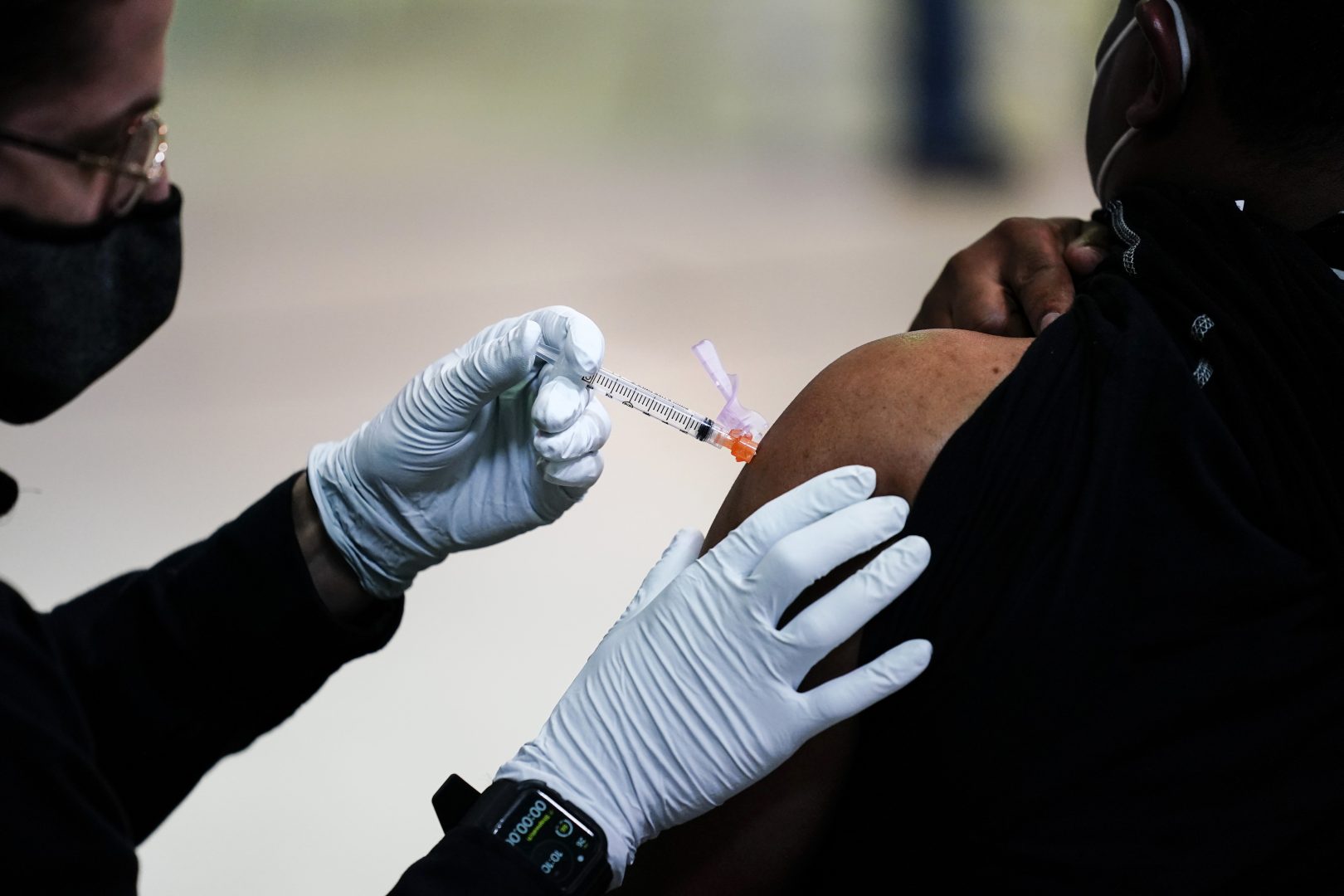
A member of the Philadelphia Fire Department administers the Johnson & Johnson COVID-19 vaccine to a person at a vaccination site at a Salvation Army location in Philadelphia on March 26, 2021.
Matt Rourke / AP Photo

A member of the Philadelphia Fire Department administers the Johnson & Johnson COVID-19 vaccine to a person at a vaccination site at a Salvation Army location in Philadelphia on March 26, 2021.
Matt Rourke / AP Photo

Matt Rourke / AP Photo
A member of the Philadelphia Fire Department administers the Johnson & Johnson COVID-19 vaccine to a person at a vaccination site at a Salvation Army location in Philadelphia on March 26, 2021.
(Pittsburgh) — A cursory glance at September COVID-19 data from Pennsylvania’s health department might lead some to conclude the vaccines are far less effective than they actually are, but a deeper look at who is vaccinated and who isn’t paints a different picture.
In September, 26% of COVID hospitalizations and 26% of new cases were breakthrough infections, according to a recent report. While the protection created by vaccination wanes, those figures don’t mean the vaccines fail a quarter of the time. Rather, it’s important to understand how Pennsylvania’s vaccinated and unvaccinated populations differ.
The Centers for Disease Control and Prevent reports that vaccinated and unvaccinated residents comprise 41% and 59% of Pennsylvanians respectively. And though they’re a minority, unvaccinated people account for 74% of last month’s hospitalizations and newly confirmed cases.
When discussing the data last week, the state’s acting Physician General Dr. Denise Johnson explained that as more people become vaccinated, the percentage of breakthrough cases will increase.
“Vaccines are not 100%,” she said. “If 100% of people [in the state] are vaccinated, we’re still going to have some cases, and then those cases will be 100% of the vaccinated.”
Vaccinated Pennsylvanians skew older, putting them at higher risk for breakthrough infections.
“When you’re in the older age group you tend to have other risk factors,” said Faina Linkov, chair of Duquesne University’s public health school.
Additionally, elderly people tend to have less robust responses to any immunization.
Among those who are eligible, teens and then people under 30 are the least likely to be vaccinated. Children under 12 aren’t approved for the immunization, though soon that’s likely to change. But unlike the flu, which tends to be most deadly to the very young and the very old, COVID-19 fatalities rates increase steadily with age making children the least likely to suffer severe illness.
Oversimplification of hospitalization data can erroneously frame outcomes as “black and white,” remarked Dr. Graham Snyder, UPMC’s director of infection prevention and hospital epidemiology.
“It’s not just being hospitalized or not,” he said, “but how complicated or long is your hospitalization?”
For example, a study looking at Los Angeles hospitalizations from May through July 25 found that unvaccinated patients are more than twice as likely to be put on ventilators. Another study found that roughly half of these patients survive. But after, many are left with lung damage and delirium. Others can develop dangerous pressure ulcers or memory issues. Also, patients will likely need speech or physical therapy due to atrophy of their muscles that occurred while they were unconscious.
A misconception among some patients is that the vaccine can help them after they get sick. The vaccine is preventative medicine, so it only guards against coming down with an infection or serious illness.
The delta variant caused cases to surge after many older Americans were vaccinated. This made it difficult to parse out data to determine exactly how much benefit the vaccine provides.
Furthermore, September’s vaccine report includes Pennsylvanians who were fully vaccinated in mid-January all the way to people who only became fully vaccinated last month. But those who more recently got their shots have stronger immune responses. As a result, the risk of a COVID exposure varies greatly among this population.
The CDC has approved a Pfizer booster shot for those with certain health conditions or who are over 64. The same is expected for vaccines from Moderna and Johnson & Johnson.
Finally, the level of transmission in a community plays a role. The more virus that is circulating, the more breakthrough cases will occur. A Facebook post from Johns Hopkins Bloomberg School of Public Health likens the vaccine to snow boots. Though better than regular shoes, if snow is really high it can still get into someone’s boots “but at least you’re not getting frostbite.”
What’s clear, notes Linkov, is while various studies and datasets give different answers as to the exact degree of protection, all show that “no matter what data source you’re looking at–European, American–it appears that vaccines are effective at preventing those really adverse outcomes.”

A collection of interviews, photos, and music videos, featuring local musicians who have stopped by the WITF performance studio to share a little discussion and sound. Produced by WITF’s Joe Ulrich.
The days of journalism’s one-way street of simply producing stories for the public have long been over. Now, it’s time to find better ways to interact with you and ensure we meet your high standards of what a credible media organization should be.